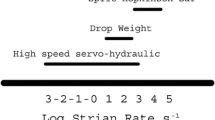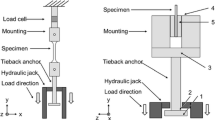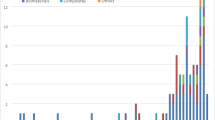Abstract
A novel drop tower modification was designed and implemented in order to enable tensile coupon testing at medium strain rate regime (1–200/s), using a drop weight apparatus, instead of intermediate strain rate servo-hydraulic tensile machines. The developed tensile device, which consists of one movable and one rigid frame, has the ability to transform the compression loading of a drop tower machine into tension loading on the specimen. A simulation model of the proposed concept has been developed in the explicit FE code LS-DYNA and validated by experimental measurements of load and displacement histories. During the development phase, the model was used for the device preliminary design, i.e. the selection of the optimal acquisition sensor locations and the introduction of an absorber material in order to avoid undesired vibrations, as well as for the sizing of the main components of the device. During the testing phase, the numerical model was used for the determination of the appropriate testing parameters which lead to the desired testing conditions (velocity, strain rate and load level). The final design of the tensile device was implemented in an Instron drop tower machine and initial experimental tests were performed for the assessment of the proposed method. Details of the material types and specimen geometries that were tested, as well as impact testing parameters, such as range of strain rate, energy and velocity are comprehensively described in this paper. It was demonstrated that the proposed device can serve as a cost effective alternative of servo-hydraulic tensile machines, is compatible to Digital Image Correlation optical devices due to the good optical access to the tested specimen and does not introduce significant ringing effects in the piezoelectric load cell; therefore, it is suitable for medium strain rate tensile testing.



















Similar content being viewed by others
References
Sierakowski RL (1997) Strain rate effects in composites. Appl Mech Rev 50:741–761
Hamouda AMS, Hashmi MSJ (1998) Testing of composite materials at high rates of strain: advances and challenges. J Mater Process Tech 77:327–336
Yang X, Hector LG Jr, Wang J (2014) A combined theoretical/experimental approach for reducing ringing artifacts in low dynamic testing with servo-hydraulic load frames. Exp Mech 54:775–789
Hopkinson B (1921) The scientific papers of Bertram Hopkinson. Cambridge University Press, Cambridge
Landon JW, Quinney H (1923) Experiments with the Hopkinson pressure bar. Proc R Soc A 103:622–643
Davies RM (1948) A critical study of the Hopkinson pressure bar. Philos T R Soc 240:375–457
Kolsky H (1949) An investigation of the mechanical properties of materials at very high rates of loading. P Phys Soc B 62:676–700
Lindholm US (1964) Some experiments with the split Hopkinson pressure bar. J Mech Phys Solids 12:317–335
Lindholm US, Yeakley LM (1965) Dynamic deformation of single and polycrystalline aluminium. J Mech Phys Solids 13:41–53
Hsiao HM, Daniel IM, Cordes RD (1998) Dynamic compressive behavior of thick composite materials. Exp Mech 38:172–180
Gilat A, Goldberg RK, Roberts GD (2002) Experimental study of strain-rate-dependent behavior of carbon/epoxy composite. Compos Sci Technol 62:1469–1476
Schaefer JD, Werner BT, Daniel IM (2014) Strain-rate-dependent failure of a toughened matrix composite. Exp Mech 54:1111–1120
Dunand M, Gary G, Mohr D (2013) Load-inversion device for the high strain rate tensile testing of sheet materials with Hopkinson pressure bars. Exp Mech 53:1177–1188
Hauser FE (1966) Techniques for measuring stress–strain relations at high strain rates. Exp Mech 6:395–402
Duffy J, Campbell JD, Hawley RH (1971) On the use of a torsional split Hopkinson bar to study rate effects in 1100–0 aluminum. J Appl Mech 38:83–91
Nie X, Prabhu R, Chen WW, Caruthers JM, Weerasooriya T (2011) A Kolsky torsion bar technique for characterization of dynamic shear response of soft materials. Exp Mech 51:1527–1534
Xiao X (2008) Dynamic tensile testing of plastic materials. Polym Test 27:164–178
Toso NRS (2009) Contribution to the modelling and simulation of aircraft structures impacting on water. Dissertation, Universität Stuttgart
Jaspers SPFC, Dautzenberg JH (2002) Material behaviour in metal cutting: strains, strain rates and temperatures in chip formation. J Mater Process Tech 121:123–135
Kalpakjian S, Schmid SR (2008) Manufacturing processes for engineering materials, 5th edn. Pearson Education, New York
Altan T, Tekkaya A (2012) Sheet metal forming: processes and applications. ASM International, Ohio
Liu W (2015) Identification of strainrate dependent hardening sensitivity of metallic sheets under in-plane biaxial loading. Dissertation, INSA de Rennes
Song B, Chen WW, Lu W-Y (2007) Mechanical characterization at intermediate strain rates for rate effects on an epoxy syntactic foam. Int J Mech Sci 49:1336–1343
Othman R, Guegan P, Challita G, Pasco F, LeBreton D (2009) A modified servo-hydraulic machine for testing at intermediate strain rates. Int J Impact Eng 36:460–467
Larour P (2010) Strain rate sensitivity of automotive sheet steels: influence of plastic strain, strain rate, temperature, microstructure, bake hardening and pre-strain. Dissertation, RWTH Aachen
Whittington WR, Oppedal AL, Francis DK, Horstemeyer MF (2015) A novel intermediate strain rate testing device: the serpentine transmitted bar. Int J Impact Eng 81:1–7
Matera R, Albertini C, Stoloff NS (1978) The mechanical behavior of aligned eutectics at high rates of strain. Mater Sci Eng 32:267–276
Daniel IM, Liber T (1978) Testing of fibrous composites at high strain rates. Proceedings of Second International Conference on Composite Materials 1003–1018
Zhu D, Rajan SD, Mobasher B, Peled A, Mignolet M (2011) Modal analysis of a servo-hydraulic high speed machine and its application to dynamic tensile testing at an intermediate strain rate. Exp Mech 51:1347–1363
Broutman LJ, Rotem A (1975) Impact strength and toughness of fiber composite materials. ASTM STP 568:114–133
Wu JS, Friedrich K, Grosso M (1989) Impact behaviour of short fibre/liquid crystal polymer composites. Composites 20:223–233
Lifshitz JM (1976) Impact strength of angle ply fiber reinforced materials. J Compos Mater 10:92–101
Marom G, Drukker E, Weinberg A, Banbaji J (1986) Impact behaviour of carbon/Kevlar hybrid composites. Composites 17:150–153
Gustin J, Mahinfalah M, Nakhaie Jazar G, Aagaah MR (2004) Low-velocity impact of sandwich composite plates. Exp Mech 44:574–583
Daniel IM, Abot JL, Schubel PM, Luo J-J (2012) Response and damage tolerance of composite sandwich structures under low velocity impact. Exp Mech 52:37–47
Savic V, Pawlicki M, Krajewski P, Voss M et al (2014) Passive pedestrian protection approach for vehicle hoods. SAE. doi:10.4271/2014-01-0513
Taheri-Behrooz F, Shokrieh MM, Abdolvand HR (2013) Designing and manufacturing of a drop weight impact test machine. Eng Solid Mech 1:69–76
Gilbert CJ, Ritchie RO, Johnson WL (1997) Fracture toughness and fatigue-crack propagation in a Zr-Ti-Ni-Cu-Be bulk metallic glass. Appl Phys Lett 71:476–478
Atkins AG, Lee CS, Caddell RM (1975) Time-temperature dependent fracture toughness of PMMA. J Mater Sci 10:1394–1404
Fernie R, Warrior NA (2002) Impact test rigs for high strain rate tensile and compressive testing of composite materials. Strain 38:69–73
Chan JJ (2009) Design of fixtures and specimens for high strain-rate tensile testing on a drop tower. BSc thesis, Massachusetts Institute of Technology
Reedlunn B, Daly S, Hector L Jr, Zavattieri P, Shaw J (2013) Tips and tricks for characterizing shape memory wire part 5: Full-field strain measurement by digital image correlation. Exp Techniques 37:62–78
ASTM standard E8/E8M (2009) Standard test methods for tension testing of metallic materials
DASSAULT Aviation. http://www.dassault-aviation.com
Kobayashi T, Toda H, Masuda T (2002) Analysis of test data obtained from Charpy V and impact tensile test. ESIS Publ 30:173–180
Smart Aircraft in Emergency Situations (SMAES), FP7-AAT-2010-RTD-1, 2011–2014, Deliverable 4.10 ‘Data on T4.2 material characterization tests and material model information’
ANSYS 11.0 Documentation, ANSYS INC
LS-DYNA (2006) Theory manual, Livermore Software Technology Corporation
Chang FK, Chang KY (1987) A progressive damage model for laminated composites containing stress concentrations. J Compos Mater 21:834–855
Avallone EA, Baumeister T, Sadegh AM (2007) Marks’ standard handbook for mechanical engineers, 11th edn. Mc Graw Hill, New York
Sahraoui S, Lataillade JL (1998) Analysis of load oscillations in instrumented impact testing. Eng Fract Mech 60:437–446
Fujii Y (2003) Proposal for a step response evaluation method for force transducers. Meas Sci Technol 14:1741–1746
Ahn SJ, Jeong WB, Yoo WS (2004) An estimation of error-free frequency response function from impact hammer testing. JSME Int J C-Mech Sy 47:852–857
Found MS, Howard IC, Paran AP (1998) Interpretation of signals from dropweight impact tests. Compos Struct 42:353–363
Zhu D, Gencoglu M, Mobasher B (2009) Low velocity flexural impact behavior of AR glass fabric reinforced cement composites. Cem Concr Comp 31:379–387
SAE Standard J2749 (2008) High strain rate tensile testing of polymers
Yan B, Kuriyama Y, Uenishi A, Cornette D et al (2006) Recommended practice for dynamic testing for sheet steels - development and round robin tests. SAE. doi:10.4271/2006-01-0120
Wagoner MP, Buttlar WG, Paulino GH (2005) Disk-shaped compact tension test for asphalt concrete fracture. Exp Mech 45:270–277
Ayatollahi MR, Aliha MRM (2009) Analysis of a new specimen for mixed mode fracture tests on brittle materials. Eng Fract Mech 76:1563–1573
ASTM Standard D5961 (2003) Standard test method for bearing response of polymer matrix composite laminates
Tao H, Zavattieri PD, Hector LG Jr, Tong W (2010) Mode I fracture at spot welds in dual-phase steel: an application of reverse digital image correlation. Exp Mech 50:1199–1212
Marya M, Wang K, Hector LG Jr, Gayden X (2006) Tensile-shear forces and fracture modes in single and multiple weld specimens in dual-phase steels. J Manuf Sci Eng-T ASME 128:287–298
Acknowledgments
The present work is partly funded by the EU, in the frame of ‘SMart Aircraft in Emergency Situations’ (SMAES) - RTD project, Contract No. ACP0-GA-2010-266172. The authors would like to express their gratitude to DASSAULT Aviation for designing and providing the composite tensile samples.
Author information
Authors and Affiliations
Corresponding author
Appendix
Appendix
Appendix 1: Abbreviations
- APDL:
-
ANSYS Parametric Design Language
- CT:
-
Compact Tension
- DIC:
-
Digital Image Correlation
- DOF:
-
Degree Of Freedom
- Eα :
-
Young Modulus at the principal longitudinal material axis
- Eb :
-
Young Modulus at the principal transverse material axis
- FAIL:
-
Plastic strain at failure
- FE:
-
Finite Elements
- FFT:
-
Fast Fourier Transformation
- fps:
-
frames per second
- Gαb :
-
In-plane shear modulus
- GFRP:
-
Glass Fibre Reinforced Plastic
- HV:
-
High Velocity
- LVDT:
-
Linear Variable Differential Transformer
- PFV:
-
Photron FASTCAM Viewer
- PMMA:
-
Poly(Methyl MethAcrylate)
- Sc:
-
In-plane shear strength
- SHPB:
-
Split Hopkinson Pressure Bar
- Xt, Xc:
-
Longitudinal tensile and compressive strength
- Yt, Yc:
-
Transverse tensile and compressive strength
- ναb :
-
Poisson ratio
- 2D, 3D:
-
Two and three dimensional
Rights and permissions
About this article
Cite this article
Perogamvros, N., Mitropoulos, T. & Lampeas, G. Drop Tower Adaptation for Medium Strain Rate Tensile Testing. Exp Mech 56, 419–436 (2016). https://doi.org/10.1007/s11340-015-0112-3
Received:
Accepted:
Published:
Issue Date:
DOI: https://doi.org/10.1007/s11340-015-0112-3




